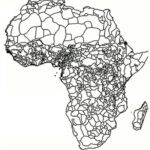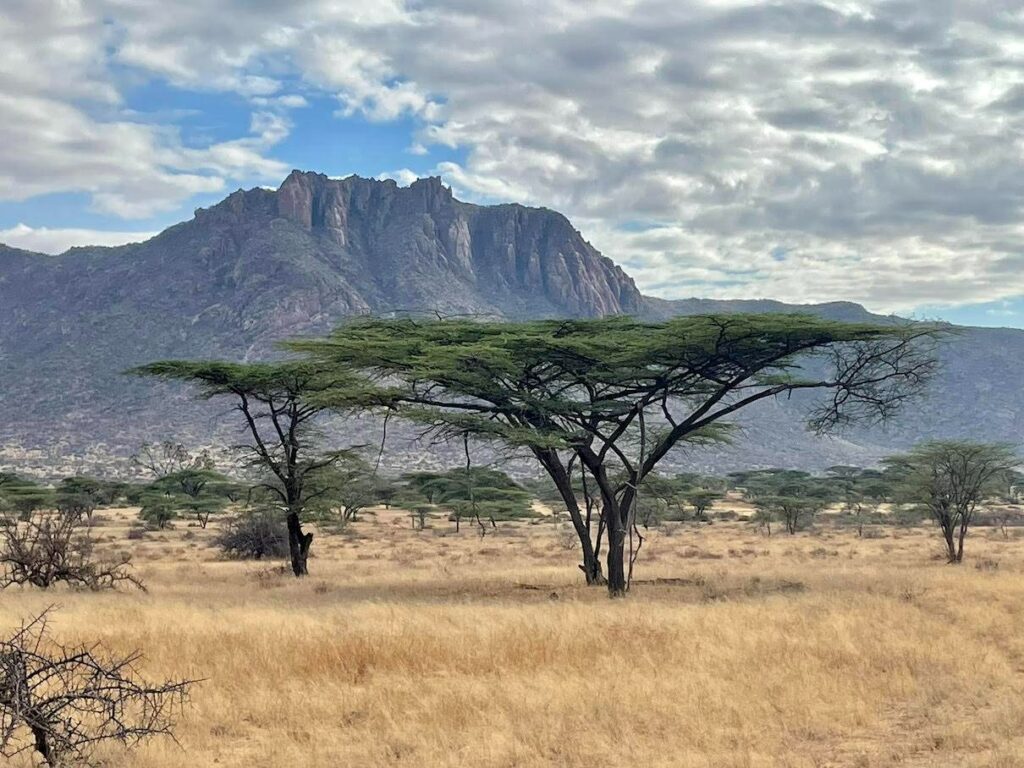- Pastoralism provides much of the milk and protein consumed in Kenya, but it faces a perilous future especially from climate change but also a lack of infrastructure and land rights.
- Recent droughts have exacerbated the challenges, leading to conflict between pastoralist communities struggling to find enough forage and water for livestock.
- Fresh ideas and new programs are arising to help ease the situation in areas of northern Kenya, from where this dispatch originates.
- This post is a commentary. The views expressed are those of the author, not necessarily of Mongabay.
‘Wabi-sabi’ is a world view about finding beauty in nature’s imperfections.
It perfectly describes pastoralism in northern Kenya – where nomadic livestock herders scrape out a living by moving their animals from place to place in search of water and grass in a dry and unforgiving landscape.
For at least 10,000 years, this migratory lifestyle has supported more than a half-million Samburu, Turkana and Rendille communities scattered across this vast region dotted with thorn trees, dwarf shrubs and little else. It stretches from the dusty town of Isiolo in the south to the Ethiopia and Somalia borders in the north and east. Livestock, mostly goats, cattle and camels, are the primary food and income source for pastoralists living on these collectively owned and arid lands.
But pastoralism faces perilous threats today from climate change, population growth, land pressures and tribal conflicts. Warmer temperatures and more extreme droughts are increasing the number of livestock raids among tribes across the region. Land encroachment from agriculture interests and wildlife-focused conservancies in the south are also shrinking traditional grazing territories.
“Our biggest problem is climate change,” said Christopher Ogom, a Samburu pastoralist and local leader in the village of Gatab, who lost most of his goats and cattle during a devastating four-year drought that ended in April. “Food security is a big problem due to the loss of animals. Many people are still depending on relief (assistance).”
Ndurra Tarakino, a Rendille pastoralist with some of his camels at the Civicon borehole, a key water source for herders near Mount Kulal in northern Kenya. Image courtesy of Peyton Fleming.
And it isn’t just indigenous tribes with their deep cultural knowledge who are threatened by these trends. Pastoralism plays a critical role in conserving open landscapes that support elephants and giraffes which drive tourism. It protects biodiversity and provides carbon sinks, sequestering up to 5 million tons of carbon per acre per year. Pastoralism also provides much of the milk and meat consumed in Kenya.
I recently spent 10 days traveling to remote settlements, watering holes and villages across northern Kenya. I witnessed the challenges pastoralists are facing and the solutions that are giving them hope in this expanse of savannahs, scrublands and dry grasslands. Oddly enough, my trip began with rain.
Water holes, mud and camel milk
Kenya’s arid and semi-arid lands in southern and northern Kenya are reeling from a string of recent withering droughts that turned grassland to dust, the longest one being from 2020 to early 2023. By last fall, according to ReliefWeb, more than 2.4 million livestock had perished for lack of food and water, and more than 4.2 million people were suffering from acute food insecurity.
The first seasonal rains returned for a few weeks in April, followed by a second round that began on Oct. 17, the first day of my trip north from Nairobi.
After passing through Isiolo, a key transport hub for Lorries heading to Ethiopia 170 miles north of the capital, the rugged empty landscape immediately became dry and brown, even after rains the night before. One hour later, I saw my first camels, first a handful, then dozens. Cow bells clanged around many of their necks while being herded by young pastoralist boys who survive for days at a time on camel milk.
Thirty miles further north, I visited a Rendille settlement, a cluster of two dozen huts made from tree branches and plastic. Nestled behind a mountain, the rainy season had transformed the bumpy path to the settlement into slurry of mud up to a foot deep.
A Rendille settlement purposefully located at the base of a mountain for water access and security from cattle raids. Image courtesy of Peyton Fleming.
The Rendille families moved here during the drought so they could have better access to a manmade water catchment that collects water from the mountain. The location is also considered safer for the women and young girls who live here mostly alone while men and boys are away with their herds.
Soon after leaving the settlement and traveling east, dozens of herds of goats, cattle and camels were assembled a few-hundred yards off the road. Moments later, I saw the reason why: A half-dozen concrete troughs filled to the brim with clean, bountiful water.
Basic infrastructure brings enormous value to this marginalized region crisscrossed by unmarked dirt roads on dried-out riverbeds. Take the new A2 highway, built by a Chinese company from Isiolo to the Ethiopian border: this has reduced travel times dramatically, allowing hay, food and livestock to be transported more quickly across the region.
Well-maintained boreholes – deep groundwater wells often outfitted with solar pumps – also improve local livelihoods. The borehole I visited is a direct result of a green energy boom underway in Kenya. When the Lake Turkana Wind Power Project, Africa’s largest wind power facility, was built a decade ago, the company dug a 420-meter-deep well to provide water for the construction crews (power from the wind farm is all going south to Nairobi; none is available for local pastoralists who live without electricity).
The community borehole, known as Civicon, is popular among Samburu and Rendille herders who come from all directions with their goats, camels and cattle. One of those herders is Ndurra Tarakino, a Rendille man who lost three of his children in a fight over livestock several years ago with the Turkana tribe. Today he’s herding about four dozen cattle and camels, along with more than 50 goats – a far cry from the size of his herds before the drought.
Still, he’s thankful he can bring his animals to this borehole instead of the longer, more arduous task of moving them up into a nearby mountain forest, Mount Kulal, whenever it gets dry. For years, herders like Tarakino lived on the lush green mountain with their livestock and families during droughts, but because of the environmental damage they were causing to the mountain’s rich diversity of trees, plants and birds, they were evicted seven years ago.
“This has made my life much easier,” said Tarakino, while awaiting his turn to bring his livestock to the borehole in the lowlands away from Mount Kulal. “We have no more need for the mountain.”
Clusters of camels, cattle and goats are a common sight in northern Kenya. Image courtesy of Peyton Fleming.
Coping with climate change
Twenty miles north, I stopped for two days at Gatab, a Samburu village of 3,700 people on Mount Kulal’s south side. At a meeting with four dozen members of the local Community Forest Association, made up of male elders, women and youth, myself and other visitors received an earful about the challenges the mountain is facing.
Climate change and dwindling water supplies were the biggest concerns. The mountain was no longer ‘misting’ because of hotter temperatures. Seasonal rains were less reliable. Droughts lasted years instead of months. It was all about water.
For as long as anyone could remember, the mountain’s numerous springs have always provided water. Not anymore. Even with the recent rains last spring, critical water sources near the top of Mount Kulal stopped producing during the summer and fall.
“Two springs that we depended on in the upper village are dry,” said Shadrack Lengoyiap, secretary of the Community Forest Association, speaking in mid-October. “There’s only one spring left in the forest that we can use (in Gatab).”
After heavy rains in early November, the springs began flowing again, but community members are still nervous about the future.
They offer specific suggestions for solving the water gap, including drilling new boreholes, pumping water from the Civicon borehole – even building a dam near the top of the mountain.
But who has the money to pay for a $200,000 borehole, let alone a dam? Certainly not Gatab or Marsabit County, where most families are living in poverty.
A Rendille girl with a camel in northern Kenya. Image courtesy of Peyton Fleming.
A more resilient pastoralism
There are lots of ideas for making pastoralism more financially viable, whether by modifying livestock practices, strengthening land rights, or diversifying economic livelihoods.
Securing pastoralists’ community land right is a foundational step that will provide stability and reduce conflicts over scarce land resources. With support from IMPACT Kenya, a nonprofit supporting Indigenous groups, more than a dozen pastoralist communities in Laikipia and Samburu counties have successfully registered their lands in the past three years.
Transitioning to climate-resilient livestock is another important step. Local pastoralists are increasingly switching from cattle to camels, which require less water and grass. Chickens, long a taboo among pastoralists, are becoming more commonplace in settlements, too. New mobile fencing innovations that shield livestock from wildlife attacks at night, while recharging vegetation, are also gaining traction in southern Kenya.
Mixed farming systems, which combine crop and livestock agriculture, are another ripe opportunity. Like many countries, Kenya has been aggressively pushing tree planting to reduce deforestation and climate change impacts. Many of these efforts, in Gatab and elsewhere, include fruit trees such as oranges, mangoes and avocados, which can improve diets and income diversification.
Putting fruit tree saplings in the hands of women and youth is an especially popular idea being pushed by government and nonprofit groups such as BOMA, which is supporting more than 100 women-led tree nurseries in Marsabit and Samburu counties.
A larger and more controversial opportunity is a carbon credit project which claims to increase carbon storage in areas of northern Kenya by managing Indigenous livestock grazing routes. Launched a decade ago, the Northern Kenya Rangelands Carbon Project has paid out millions of dollars in carbon credits to a dozen ‘community conservancies’ for modifying traditional grazing practices, protecting wildlife and other conservation activity. The projects, mostly in greener areas closer to Nairobi and wildlife parks, are financed with carbon offsets paid for by global companies.
The northern Kenya landscape is dry most of the year, making it unsuitable for growing crops. Image courtesy of Peyton Fleming.
While the project’s climate and community benefits – particularly in terms of benefits for local pastoralists – have been broadly questioned, community conservancies say the money helps pay for community activities like education and water sourcing that would otherwise be unavailable.
Yet there is no appetite for these projects further north near Mount Kulal, where an isolated mountain surrounded by a rugged desert is not suitable for elephants, lions and other wildlife that attract tourists.
“A conservancy to protect the forest is something we’d be open to,” said Christopher Ogom, chair of the Mount Kulal Community Forest Association. “But nobody has approached us to talk about it.”
For Malih Ole Kaunga, executive director of IMPACT Kenya, this is the challenge facing pastoralism in Kenya.
“Unless it can be commoditized with iconic wildlife and tourism, it’s easy to be overlooked and marginalized,” he said.
My visit underscored this thought: It’s too easy to focus government spending and carbon offsets to protect beloved wildlife and their habitats. Given that traditional pastoralists and their durable livelihoods have been protecting landscapes that deliver important – but less charismatic – benefits for thousands of years, they also deserve more support in terms of infrastructure, climate resiliency tools and legal land protections.
This article was first published on Mongabay

